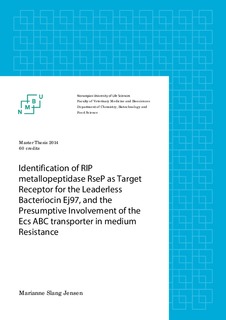| dc.description.abstract | In a recent study on the leaderless and Lactococcus-specific bacteriocin LsbB, the results implied that LsbB utilizes a zinc-dependent metallopeptidase YvjB from the M50 superfamily as receptor for target recognition and subsequent killing of other lactococcal bacteria.
Based on this evidence, another study was initiated which elucidated a conserved motif near the C-terminal of LsbB, proving to be crucial for its activity. The work also revealed that several other leaderless bacteriocins, including Ej97, K1 and EntQ, all share this conserved motif with LsbB, suggesting that they target the same receptor. Despite this similarity, these bacteriocins display a significantly broader inhibition spectrum than LsbB.
For this thesis, it was initially affirmed that Ej97 and K1 exhibit a wide inhibition spectrum relative to LsbB, followed by generation of approximately 80 spontaneous mutants resistant to Ej97, K1 or EntQ. These mutants belonged to pediococcal, enterococcal and lactococcal strains. The homologous genes of the LsbB receptor (rseP) were identified in order to be sequenced and analyzed in all the collected mutants. Severe mutations inflicting premature termination of RseP were in many cases revealed. This suggests that these RseP proteins which are closely related to the LsbB receptor also serve as docking molecules in other bacterial species for LsbB-like bacteriocins. They are however unable to function as receptor for LsbB.
Still, a large proportion of the mutants did not hold mutations within the putative RseP receptor. Phenotypic microtiter assays were performed to investigate Ej97 resistance levels. It became evident that the degree of resistance generally diverged into two levels – one very high indicating absolute resistance, and a lower level but still significantly higher than in the wild type. Interestingly, the mutants with the highest resistance level coincided with the presence of dysfunctional RseP.
Concluding the work for this thesis, whole genome sequencing of 40 mutants was carried out to identify possible reasons for the resistance observed in mutants with intact RseP and lower level of resistance. Variant detection provided clear indications of components from the Ecs ABC-transporter being involved. After this revelation it was noticed that previous studies on non-bacteriocin systems have indicated a connection between EcsAB and RseP in other species. Future work will examine how these genes are interrelated in conferring bacteriocin resistance. | nb_NO |
